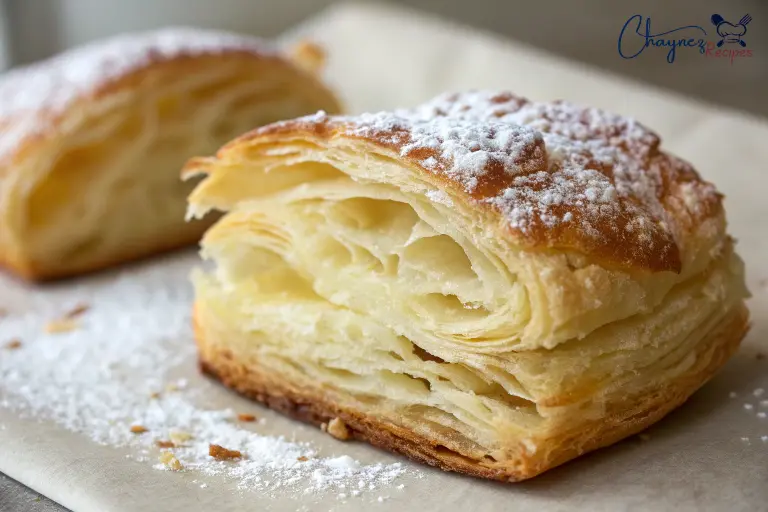Puff pastry is a culinary staple that brings a touch of sophistication and elegance to any dish. From savory appetizers to sweet desserts, the versatility of puff pastry knows no bounds. However, despite its popularity, many home bakers find themselves asking: What things should we avoid with puff pastry to ensure it turns out perfectly every time? While puff pastry might seem intimidating at first, understanding the right techniques can make all the difference between a delicious flaky pastry and one that falls flat.
In this guide, we will answer that very question and help you master the art of puff pastry. Whether you’re creating delicate croissants, savory turnovers, or a stunning mille-feuille, knowing what things to avoid with puff pastry can save you from common mistakes and elevate the final product.
With a few simple tips and tricks, you’ll discover how to work with puff pastry like a pro, avoiding the pitfalls that even seasoned bakers sometimes make. So, let’s dive into the must-know tips that will guide you on your journey to creating the most mouthwatering, golden, and flaky puff pastry.
Understanding Puff Pastry
Before diving into the mistakes to avoid, it’s important to understand what makes puff pastry unique. Puff pastry is a dough made from layers of butter and flour. The dough is rolled and folded repeatedly to create thin, delicate layers that puff up when baked. This process creates a light, airy texture that is the hallmark of a great puff pastry.
However, creating the perfect puff pastry is not as easy as it sounds. Even slight missteps can lead to tough, uneven, or greasy pastries. So, let’s break down some of the common pitfalls.
1. Overworking the Dough
One of the most common mistakes when working with puff pastry is overworking the dough. While it might seem tempting to knead and fold the dough excessively, doing so can ruin its texture.
Why Overworking Is Problematic:
- Tough Pastry: Overworking the dough causes the gluten to develop, leading to a dense, tough texture.
- Poor Layering: The layers of butter and dough will not separate as they should, resulting in a lack of flakiness.
How to Avoid It:
- Handle the dough gently and only as much as necessary.
- Use a light touch when folding and rolling.
- If the dough becomes too soft, chill it before continuing.
2. Not Chilling the Dough Enough
Chilling the dough is essential when making puff pastry. The process of folding the dough and butter together creates a lot of heat, which can soften the butter. This leads to less distinct layers and a less crisp texture when baked.
Why Chilling is Crucial:
- Prevents Butter from Melting: The butter needs to stay solid for the layers to form correctly.
- Helps Maintain Shape: Chilling the dough helps it hold its shape better while rolling.
How to Avoid It:
- After each fold, wrap the dough in plastic and refrigerate for at least 30 minutes.
- If you notice the dough becoming too soft during preparation, give it a longer chill.
3. Using Too Much Flour
When rolling out puff pastry, it can be easy to reach for the flour to prevent sticking. However, using too much flour can create problems with texture and prevent the dough from rising properly.
Why Excess Flour Is Harmful:
- Damp Dough: Too much flour can dry out the dough, preventing it from puffing correctly in the oven.
- Unwanted Texture: Excess flour can make the pastry dry and less tender.
How to Avoid It:
- Lightly dust your surface with flour rather than over-flouring.
- Use parchment paper or silicone mats to prevent sticking instead of flouring excessively.
4. Overfilling the Pastry
While it’s tempting to load your puff pastry with a generous amount of filling, overstuffing can lead to some serious issues when baking.
Why Overfilling is a Problem:
- Spillage: Excess filling can spill out while baking, creating a mess.
- Uneven Baking: Too much filling prevents the pastry from cooking evenly, leaving it soggy in the center.
How to Avoid It:
- Be mindful of how much filling you’re adding, ensuring it stays within the borders.
- If using wet ingredients like sauces, try to reduce the moisture before filling the pastry.
5. Not Preheating the Oven
Puff pastry requires high heat to achieve its signature rise and flaky texture. Failing to preheat the oven can result in pastries that do not puff properly and become dense or soggy.
Why Preheating is Essential:
- Consistent Heat: Without preheating, the heat in the oven is uneven, which can affect the puffing process.
- Better Texture: A properly preheated oven ensures that the pastry cooks quickly and crisply.
How to Avoid It:
- Always preheat your oven to the correct temperature before placing your puff pastry inside.
- Use an oven thermometer to confirm the accuracy of your oven’s temperature.
6. Skipping the Egg Wash
Egg wash is one of the final touches that can make your puff pastry look and taste even better. Without it, your pastry may lack that golden, shiny finish.
Why Egg Wash Matters:
- Golden Finish: An egg wash creates a beautifully golden crust on the pastry.
- Texture: It also helps to create a crisp, glossy texture.
How to Avoid It:
- Before baking, brush your pastries with a mixture of egg and water or milk for a shiny, crisp finish.
- Make sure to apply a thin, even coat.

7. Baking at the Wrong Temperature
Baking puff pastry at too low or too high a temperature can affect its final result.
Why Baking Temperature is Important:
- Low Temperature: Baking at a low temperature can cause the pastry to become soggy because it won’t cook quickly enough.
- High Temperature: On the other hand, baking at too high a temperature can cause the pastry to burn before it fully puffs.
How to Avoid It:
- Aim for a temperature of about 400°F (200°C) for most puff pastry recipes.
- Make adjustments based on the size and type of your pastry for optimal results.
8. Not Using the Right Type of Butter
The butter you use in puff pastry plays a huge role in its flavor and texture. Using the wrong kind can result in a less-than-ideal puff pastry.
Why Butter Type Matters:
- Flavor: Unsalted butter allows you to control the salt levels in your dough.
- Texture: Good-quality butter ensures that the pastry remains flaky and light.
How to Avoid It:
- Choose unsalted butter with a high fat content for the best results.
- Avoid using margarine or low-fat butters, as they will not yield the same crispness and flavor.
9. Opening the Oven Door Too Often
Opening the oven door during baking is another mistake that can hinder your puff pastry’s performance. Puff pastry requires consistent heat to rise properly.
Why Opening the Oven is Harmful:
- Temperature Drop: Every time the door is opened, the oven loses heat, which can cause the pastry to deflate.
- Uneven Cooking: It can also result in uneven baking and prevent the layers from forming correctly.
How to Avoid It:
- Avoid opening the oven door unless absolutely necessary.
- If you must check on the pastries, do so quickly to minimize heat loss.
FAQs: What things should we avoid with puff pastry?
1. What things should we avoid with puff pastry to prevent it from becoming tough?
To avoid tough puff pastry, don’t overwork the dough. Handle it gently and chill it between folds to keep the butter solid and the layers distinct.
2. What things should we avoid with puff pastry to ensure it puffs up properly?
Avoid baking at too low a temperature. Preheat your oven to around 400°F (200°C) to ensure the pastry cooks quickly and puffs up as intended.
3. What things should we avoid with puff pastry when adding a filling?
Don’t overfill your puff pastry. Too much filling can cause spillage and prevent the pastry from baking evenly.
4. What things should we avoid with puff pastry to keep it from being soggy?
Excess moisture in your filling can lead to sogginess. Reduce the liquid content before using it in your pastry to ensure a crispy texture.
5. What things should we avoid with puff pastry when rolling it out?
Avoid using too much flour when rolling out puff pastry. Excess flour can dry out the dough, affecting its ability to puff up properly.
Conclusion: What things should we avoid with puff pastry?
Mastering puff pastry can feel like a daunting task, but with the right techniques and an understanding of what things should we avoid with puff pastry, you can achieve flawless results every time. From keeping the dough cold and handling it gently to ensuring the right temperature in your oven, each step plays a crucial role in creating a light, flaky, and perfectly puffed pastry. The key is to be mindful of the common mistakes and make adjustments along the way.
Remember, a little patience goes a long way in pastry-making, and following the tips shared in this guide will ensure your puff pastry turns out golden and delicious every time. Whether you’re preparing savory bites or sweet treats, the principles of great puff pastry remain the same.
If you’re looking for more recipe inspiration or need something savory to pair with your pastry creations, check out these delicious dishes: Alfredo Chicken Noodle Soup, Steak Alfredo Recipe, and Chicken Alfredo Soup with Beef and Parmesan Cheese. These comforting meals are perfect for balancing out the rich flavors of your puff pastry creations!
By avoiding common pitfalls and following these simple guidelines, you’ll be able to create perfect puff pastry every time. Enjoy the process, experiment with different fillings, and impress your friends and family with your newfound skills!
And don’t miss out on more great ideas for healthier baking and cooking. For additional tips, recipes, and updates, follow us on Chaynez Recipes to access our latest posts and social media links.






